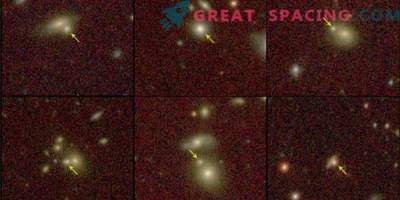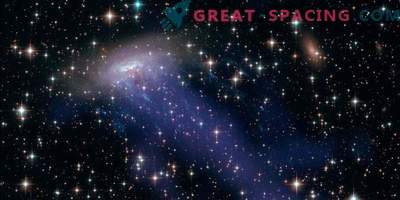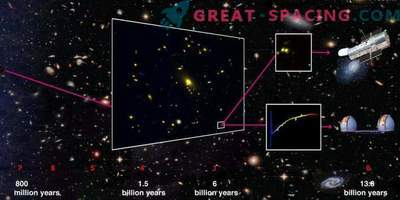
Composite image from ALMA (red) showing two SPT0311-58 galaxies. They are displayed on a background made by the Hubble Space Telescope (blue and green). You can consider the dusty glow of two galaxies. The image on the right is distorted by gravitational lensing. Nearest galaxy (lens) - green object
Researchers believe that the first galaxies that appeared several million years after the Big Bang will have similar features with some of the dwarf galaxies observed today. These early clusters will later become building blocks for large galaxies.
But the constant ALMA surveys have recorded unexpected examples of massive galaxies with stars when the age of space reached less than a billion years. So, smaller galactic building blocks could quickly organize into large galaxies.
Recent observations have advanced even further, since they revealed two large-scale galaxies, when the universe was 780 million years old (5% of the present age). In addition, they are located in a more massive cosmic structure - a halo of dark matter, exceeding solar massiveness several trillion times.
Two galaxies are close (less Earth’s distance from the galactic center) and will soon merge, forming the largest galaxy at that time. This time is called the period of reionization, when most of the intergalactic space was filled with cool gaseous hydrogen. The common name for the studied galaxies is SPT0311-58. Initially, they were identified as a single object. The first reviews showed a distant and bright formation with a huge amount of dust. Careful observations revealed the true nature of the objects.

Artistic vision of a galactic couple in early space
To get such a review, ALMA had to use a gravitational lens. She helped to understand that in the largest galaxy stars are created at a speed of 2900 solar masses per year. It also now has 270 billion solar masses and almost 3 billion times more dust.
Most likely, an active stellar birth appeared due to a collision with a neighbor, which has 35 billion solar masses, and the star formation rate is 540 solar masses per year.
Early-age galaxies are filled with more dust than the modern universe. Surprised another discovery. It turned out that the halo is one of the most massive, among those that could exist at that time.
Researchers hope to find more of such distant galaxies in order to study their features and formation process in the epoch of reionization.











































